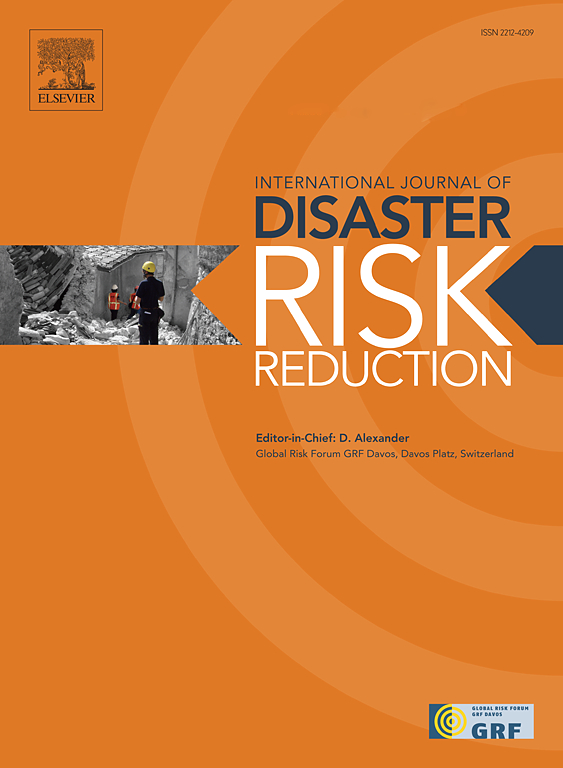A framework for appraising the status of disaster resilience within the multi-hazard environment of coastal Bangladesh
IF 4.2
1区 地球科学
Q1 GEOSCIENCES, MULTIDISCIPLINARY
International journal of disaster risk reduction
Pub Date : 2024-09-20
DOI:10.1016/j.ijdrr.2024.104832
引用次数: 0
Abstract
Fostering resilience is widely acknowledged as a crucial strategy for mitigating the escalating risks posed by climate-related disasters around the world. Resilience assessment plays a vital role in this endeavour by assessing the baseline level of resilience, identifying the key resilience factors, and monitoring progress towards building resilience with time. Given this context, and considering the evolving conceptualization of resilience, we devised a framework for appraising the status of resilience across the coastal region of Bangladesh. Our framework represents a significant scholarly contribution, as it encompasses a broad spectrum of resilience dimensions, including stability, recoverability, and transformability. To operationalize this framework, we selected thirty context-specific variables and organized them systematically around these three overarching components. Employing a simple weighted average methodology, we constructed sub-indices for each component, which were subsequently aggregated into a composite resilience index. For spatial visualization, our findings were mapped in a Geographic Information System (GIS) environment. Our analysis revealed Chattogram, Barguna, and Khulna as the most resilient districts. This manifests the potential for resilience enhancement even within areas exposed and inherently sensitive to multiple hazards through the optimal use of available resources. Notably, in the trio of districts, Barguna exhibited the highest stability index score, Chattogram showcased the highest recoverability score, and Khulna emerged with the top transformability index score. This finding underscores the significance of incorporating diverse capacities in resilience frameworks. These insights offer valuable guidance for refining resilience assessment frameworks in other developing countries of the world. Furthermore, the outcomes of our assessment can serve as a baseline for the coastal administrators of Bangladesh while developing disaster management policies and actions centering around fostering resilient communities. Thus, our study not only contributes to disaster theory, but holds practical implications for evidence-based decision-making to secure a more resilient future of the coastal communities of Bangladesh.
孟加拉国沿海多种灾害环境下的抗灾能力评估框架
人们普遍认为,提高抗灾能力是减轻世界各地与气候有关的灾害所带来的不断升级的风险的重要战略。抗灾能力评估通过评估抗灾能力的基线水平、确定关键抗灾因素以及监测随着时间推移在建设抗灾能力方面取得的进展,在这一努力中发挥着至关重要的作用。在此背景下,考虑到抗灾能力概念的不断发展,我们设计了一个评估孟加拉国沿海地区抗灾能力状况的框架。我们的框架涵盖了广泛的复原力维度,包括稳定性、可恢复性和可转化性,是一项重要的学术贡献。为了将这一框架付诸实施,我们选择了 30 个特定环境变量,并围绕这三个主要组成部分对其进行了系统化组织。采用简单的加权平均方法,我们为每个组成部分构建了子指数,随后将其汇总为综合复原力指数。为了实现空间可视化,我们在地理信息系统(GIS)环境中绘制了研究结果图。我们的分析表明,恰特格勒、巴尔古纳和库尔纳是抗灾能力最强的地区。这表明,通过优化利用现有资源,即使是在暴露于多种灾害且对多种灾害天生敏感的地区,也有可能提高抗灾能力。值得注意的是,在这三个地区中,巴古纳的稳定性指数得分最高,恰特洛格的可恢复性得分最高,而库尔纳的可转化性指数得分最高。这一发现强调了将不同能力纳入复原力框架的重要性。这些见解为完善世界其他发展中国家的复原力评估框架提供了宝贵的指导。此外,我们的评估结果还可作为孟加拉国沿海管理者在制定灾害管理政策和行动时的基准,这些政策和行动的核心是培养具有抗灾能力的社区。因此,我们的研究不仅为灾害理论做出了贡献,而且对基于证据的决策具有实际意义,可确保孟加拉国沿海社区拥有更具复原力的未来。
本文章由计算机程序翻译,如有差异,请以英文原文为准。
求助全文
约1分钟内获得全文
求助全文
来源期刊

International journal of disaster risk reduction
GEOSCIENCES, MULTIDISCIPLINARYMETEOROLOGY-METEOROLOGY & ATMOSPHERIC SCIENCES
CiteScore
8.70
自引率
18.00%
发文量
688
审稿时长
79 days
期刊介绍:
The International Journal of Disaster Risk Reduction (IJDRR) is the journal for researchers, policymakers and practitioners across diverse disciplines: earth sciences and their implications; environmental sciences; engineering; urban studies; geography; and the social sciences. IJDRR publishes fundamental and applied research, critical reviews, policy papers and case studies with a particular focus on multi-disciplinary research that aims to reduce the impact of natural, technological, social and intentional disasters. IJDRR stimulates exchange of ideas and knowledge transfer on disaster research, mitigation, adaptation, prevention and risk reduction at all geographical scales: local, national and international.
Key topics:-
-multifaceted disaster and cascading disasters
-the development of disaster risk reduction strategies and techniques
-discussion and development of effective warning and educational systems for risk management at all levels
-disasters associated with climate change
-vulnerability analysis and vulnerability trends
-emerging risks
-resilience against disasters.
The journal particularly encourages papers that approach risk from a multi-disciplinary perspective.
 求助内容:
求助内容: 应助结果提醒方式:
应助结果提醒方式:


